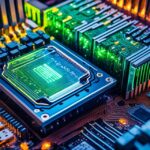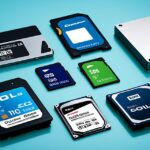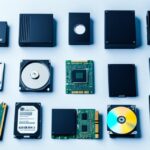Table of Contents
In today’s fast-paced tech world, understanding different computer storage types is key. We use these storage devices every day. They help us keep and organise a huge amount of data. With the amount of data expected to rise to 163 zettabytes by 2025, having good storage solutions is more important than ever1. This piece will give you a clear look into primary and secondary storage. You’ll see how they work differently and what they offer.
Primary memory, or internal memory, is crucial. It stores program instructions, input data, and temporary outcomes. Meanwhile, secondary memory is used for keeping data safe over time2. We have many storage options, like HDDs and SSDs. Each has its own set of specs and benefits for different needs. Understanding these options is vital nowadays. They are measured in MBs, GBs, and even TBs3. Next, we will dive deeper into these storage types. We’ll look at their features, pros, and cons.
Key Takeaways
- The importance of understanding different kinds of computer storage is critical for data management.
- Primary memory is essential for immediate processing, while secondary memory ensures long-term retention.
- The explosion of digital information necessitates diverse and effective storage technologies.
- Storage capacity is generally quantified in bytes, kilobytes, megabytes, gigabytes, and terabytes.
- Each storage device type offers distinct advantages, catering to specific needs and technologies.
- Future projections highlight significant growth in data generation, reinforcing the need for advanced storage solutions.
Introduction to Computer Storage
Computer storage is crucial in today’s systems. It’s the core for holding important data and instructions for tasks. The main types are storage devices, split into primary and secondary. With choices like hard disk drives (HDDs), solid-state drives (SSDs), and optical media, users have many options for their needs. Check out these storage devices.
Primary storage is also known as internal memory. It keeps data briefly for quick access, vital for CPU tasks. It used to rely on technology like rotating magnetic drums but now uses modern RAM. This holds active data temporarily. Whereas, secondary storage keeps info long-term. For example, a 1999 PATA hard disk held just 15 GB. This shows how data management technology has rapidly advanced4.
When picking storage, it’s key to understand their performance effect. Look at seek time and read/write speeds, as these impact efficiency. Nowadays, systems prefer random access storage for its speed. The evolution of technology is constantly reshaping computer storage. It’s vital to know the strengths and weaknesses of your choices5.
Understanding Primary Storage
Primary storage plays a crucial role in computer systems. It is vital for efficient data management. This storage acts as a bridge between the processor and the data in use, allowing quick data access. We will explore RAM and ROM, focusing on their functions and importance.
Random Access Memory (RAM)
RAM stands for Random Access Memory. It is a form of volatile memory that holds data temporarily during computer operations. It supports multitasking by letting programs access data quickly. However, the data vanishes when the computer shuts down. This is due to RAM’s volatile nature. The computer’s efficiency depends greatly on the RAM’s size, highlighting its importance for peak performance6. RAM comes mainly in two forms: DRAM and SRAM, each tailored to specific needs6.
Read-Only Memory (ROM)
ROM, or Read-Only Memory, differs as it’s non-volatile. It keeps essential data safe even with the computer off, which is crucial for storing system firmware and startup instructions. ROM’s data can’t be easily changed or erased, protecting vital program integrity6. Hence, ROM ensures computing devices operate reliably, safeguarding necessary boot instructions.
| Type of Storage | Volatility | Function | Example |
|---|---|---|---|
| RAM | Volatile | Temporary data storage for active tasks | DRAM, SRAM |
| ROM | Non-volatile | Permanently holds firmware and boot instructions | EPROM, EEPROM |
| Cache Memory | Volatile | High-speed buffer between CPU and RAM | N/A |
Exploring Secondary Storage Devices
Secondary storage devices are vital for holding data long-term. They perfectly complete primary storage. These devices come in magnetic, optical, and solid-state forms. Each kind is designed to meet distinct storage requirements.
Hard Disk Drives (HDD)
Hard Disk Drives, or HDDs, use magnetic storage to offer large storage spaces. Capacities range from hundreds of gigabytes to several terabytes. This makes them ideal for holding a lot of data7. They work by spinning platters to magnetically read and write data. This method has been reliable for many years. HDDs are cost-effective, offering lots of storage for less money per gigabyte compared to SSDs8.
Solid-State Drives (SSD)
Solid-State Drives are a leap forward in storage solutions. SSDs use flash memory, leading to quicker data access and better reliability. This is because they have no moving parts9. Their speed boosts overall system performance. This makes SSDs a favoured choice for both personal and business computing. Though more expensive in terms of capacity, their performance benefits often outweigh the cost8.
Kinds of Computer Storage: An In-Depth Look
Exploring computer storage, we focus on two main types: flash memory and optical storage. Each plays a key role in managing data. They offer different benefits for varying needs.
Flash Memory Devices
Flash memory devices, like USB drives and SD cards, offer convenient portable storage. They use non-volatile technology, keeping data safe without power. This means you can easily move and transfer data quickly10. Flash storage has grown, now used in many gadgets, from phones to laptops11. It’s getting more popular for its reliability and speed, over traditional hard drives.
Optical Storage Devices
Optical storage, using CDs and DVDs, works with lasers for reading and writing data. They are removable and serve different purposes. CDs are good for music and software, while DVDs hold more, great for videos12. Though not as common today, they have unique benefits worth knowing.
Looking at flash and optical storage, we see their importance in computer tech. Understanding their features helps us choose the right storage. This improves how we manage data, ensuring better performance for optimal performance.
FAQ
What are the different kinds of computer storage?
There are various types of computer storage. Primary storage includes RAM and ROM. Secondary storage includes Hard Disk Drives (HDD) and Solid-State Drives (SSD). We also have flash memory devices and optical storage for different needs.
How does primary storage differ from secondary storage?
Primary storage, with RAM and ROM, handles data immediately and is for temporary access. This makes it vital for a computer’s performance. On the other hand, secondary storage like HDDs and SSDs, keeps data for the long term.
What is the role of RAM in computer systems?
RAM (Random Access Memory) is the temporary storage for data being used. It allows computers to do many tasks at once. As volatile memory, it loses all data when the computer is off.
What advantages do SSDs offer over traditional HDDs?
SSDs (Solid-State Drives) are faster than HDDs in reading and writing data. They’re also more durable because they have no moving parts. Since they have reduced access times, they’re preferred in current computers.
Can I use flash memory devices for long-term data storage?
Yes, you can use flash memory devices like USB drives and SD cards for long-term storage. They keep data even without power, thanks to their non-volatile nature.
What types of data management solutions do optical storage devices offer?
Optical storage, such as CDs and DVDs, offers removable storage using lasers to read and write data. They’re good for audio, video, and software, making data management and transfer easy.
Source Links
- https://www.techtarget.com/searchstorage/definition/storage – What is computer storage and how is it used?
- https://www.geeksforgeeks.org/what-is-a-storage-device-definition-types-examples/ – What is a Storage Device? Definition, Types, Examples – GeeksforGeeks
- https://www.explainingcomputers.com/storage.html – ExplainingComputers.com: Storage
- https://en.wikipedia.org/wiki/Computer_data_storage – Computer data storage
- https://en.wikibooks.org/wiki/Introduction_to_Computer_Information_Systems/Storage – Introduction to Computer Information Systems/Storage – Wikibooks, open books for an open world
- https://www.shiksha.com/online-courses/articles/about-primary-storage-devices/ – All About Primary Storage Devices – Shiksha Online
- https://www.vaia.com/en-us/explanations/computer-science/computer-organisation-and-architecture/secondary-storage/ – Secondary Storage: Devices, Examples & Types
- https://medium.com/@vbammidi_46231/exploring-computer-storage-from-registers-to-secondary-memory-a2d8cd785a58 – Exploring Computer Storage: From Registers to Secondary Memory
- https://www.techtarget.com/searchstorage/definition/secondary-auxiliary-storage – What is a secondary storage device?
- https://experience.dropbox.com/get-organized/storage-devices – Types of Storage Devices
- https://www.partitionwizard.com/clone-disk/computer-storage-devices.html – Computer Storage Devices: Types & Examples and Usage – MiniTool Partition Wizard
- https://www.ibm.com/topics/data-storage – What Is Data Storage? | IBM








